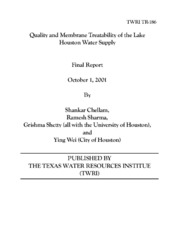| dc.description.abstract | Currently, sections of Harris and Montgomery counties located North and Northeast of Houston use groundwater almost exclusively. These areas have witnessed substantial population growth and associated increases in water demand. In 1999 approximately 60% of potable water in Houston and its adjoining communities was produced from surface water. The remaining approximately 40% was derived from groundwater. However, the "Subsidence District" which is the authority responsible for granting groundwater permits has mandated that groundwater use needs to be decreased to 20% within the next few years so as to limit subsidence.
Pipelines are not available to distribute purified water from the existing surface water treatment plants located in the South and East of Houston to the Northern areas that actually require additional water. Because Lake Houston is located in the geographical area of interest and is a surface water source, the City of Houston is interested in developing it for its future water needs. Additionally, a favorable hydraulic gradient exists from the Lake to the proposed service areas in Harris and Montgomery counties. Federal regulations such as the Stage II of the Disinfectant/Disinfection By-Products Rule (1) and the Enhanced Surface Water Treatment Rule (2) are expected to be promulgated in the near future. These rules are anticipated to introduce more stringent maximum contaminant levels (MCLs) for total trihalomethanes (THMs) and haloacetic acids (HAAs), possibly introduce new MCLs for individual species of THMs and HAAs, reduce turbidity levels, and enhance inactivation/removal requirements for Cryptosporidium. (Cryptosporidium was the causative protozoan for the more than 400,000 cases of acute gastrointestinal disease in Milwaukee, WI in March 1993.) The treatment processes in the City of Houston's existing water purification plants are not expected to be sufficient in meeting these anticipated regulations.
Therefore, both regulatory requirements and engineering considerations point towards Lake Houston as an attractive surface water source for the next water purification plant to supply potable water to the City and its adjoining communities. However, water quality in Lake Houston can be characterized as being poor with high concentrations of turbidity, color, total organic carbon (TOC), nutrients such as phosphorus and nitrogen, etc. (3).
Pressure-driven membrane processes can be employed as effective barriers against a wide range of contaminants including particles, turbidity, protozoan cysts and oocysts, bacteria, viruses, color, organic carbon, disinfection by-product (DBP) precursors, and dissolved metals. Additionally, microfiltration (MF) and ultrafiltration (UF) pretreatment may be necessary to reduce fouling rates and increase chemical cleaning intervals during surface water nanofiltration (NF) (4). Therefore, an integrated membrane system employing MF or UF pretreatment to NF is expected to be an important treatment candidate for Lake Houston water.
Nanofiltration (NF) membranes typically operate at pressures less than 100 psi and are capable of high rejections of natural organic matter (NOM) and precursors to disinfection by-products (DBP) including trihalomethanes (THMs) and haloacetic acids (HAAs) (5-8), many of which are suspected carcinogens, mutagens, or teratogens. | en |


